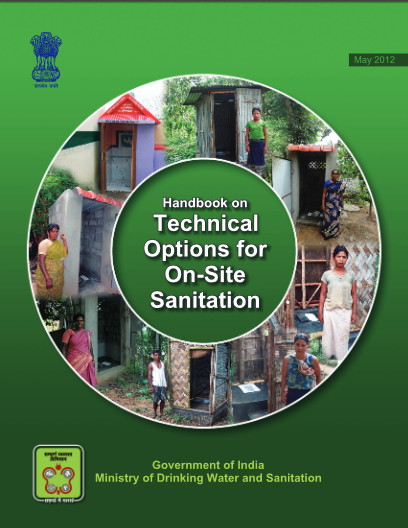Handbook on Technical options for on-site Sanitation
 |
manuel May 2012 ; 58 pages
Ed. MDWS - New Delhi
Téléchargeable chez l'éditeur
Page de présentation d'un éditeur
Abstract:
This handbook by the Ministry of Drinking Water and Sanitation provides sustainable technological options for on-site sanitation for different hydro-geological conditions.
The handbook starts with a brief description of impacts of poor sanitation facilities in India and its consequent impact on the health of the people. The impacts of good sanitation are also mentioned in the introductory chapter. These are as follows: improves health, decrease in morbidity and mortality, improves man-days, improves productivity, poverty alleviation, improves water quality, minimizes incidence of drop-out in school particularly girl students. Following which the book sheds light on the initiatives undertaken by government to arrest the problem of open defecation through Total Sanitation Campaign.
Chapter 2 is on “Linkage of sanitation, health and toilet”. It highlights the ways through which water and air borne diseases are linked human wastes. The author by presenting the information on different types of pathogens and the diseases caused by them in a tabular form shows how important it is to provide toilets to arrest most of the infection.
Chapter 3 is on “Criteria for a sanitary toilet and sustainability of sanitation”. Starting from criteria for a sanitary toilet that talks about the technical options for a designing pit latrines and chemical toilets the chapter also covers issues such as guidelines set by WHO for the safe use of waste water, excreta and grey water. The issue of sustainability of sanitation technology is also covered in the chapter.
Chapter 4 is on “Technology options for on-site sanitation”. Based on the hydro-geological conditions of the areas and socio-cultural behaviour of people this chapter focuses on technological options available that are categorised under two situations: for normal soil with low water table and for high water table areas and /rocky soil. Detailed description of different models of toilets is given along with their pictures. The advantages and disadvantages of these models are elaborated in the chapter.
Chapter 5 is on “Design criteria for pit and chamber for a household toilet”. This chapter spells out the details of common designs of toilets adopted in rural areas. The way to calculate: storage volume of a pit; depth of sludge and storage chamber for an Ecosan toilet are the core focus area of the chapter.
The last chapter is on “Key technological issues in implementing household toilets”. The common technical problems faced with implementation of household toilets and issues of operation and maintenance of household toilets are the key focus of the chapter. Contents:
1. Introduction
2. Linkage of sanitation and health
3. Criteria for a sanitary toilet and sustainabillty of sanitation
4 Technology options for household on-site sanitation
5 Design criteria for pits and chambers for a household toilet
6 Key technological problems in implementing household toilets
Bibliography
Mots clefs: |
assainissement autonome (CI) (DT) (OP) (ope) , rural (CI) (DT) (OP) (ope) , toilettes, latrine (CI) (DT) (OP) (ope) |
Pays concerné: |
Editeurs/Diffuseurs: |
|
MDWS
-
Ministry of Drinking Water and Sanitation - New Delhi - Inde |
India Sanitation Portal - - Inde |
En cas de lien brisé, nous le mentionner à communication@pseau.org